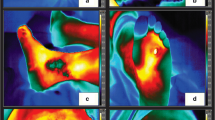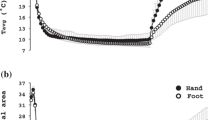Abstract
The literature indicates that rapid thawing in water between 42‡ and 45‡C provides the best prognosis for frostbitten limbs.A temperature:sensation scale for the normal hand was derived and tested in laboratory and field conditions. The scale permitted the preparation of water suitable for frostbite treatment by the majority of subjects without access to a thermometer. The maximum observed inaccuracy was 1.2‡C outside the preferred range but was well withing the safe range for treatment.
Zusammenfassung
Die beste Prognose zur Behandlung von Erfrierungen bietet nach den Erfahrungen in der Literatur das schnelle Auftauen von erfrorenen Gliedern bei Wassertemperaturen von 42–45‡C. Für die gesunde Hand wurde eine Temperatur-Wahrnehmungsskala aufgestellt und unter verschiedenen Bedingungen im Laboratorium und im Freien geprüft. Ohne Zugang zu einem Thermometer gestattete die Skala in der Mehrzahl der FÄlle die ErwÄrmung von Wasser auf Temperaturen, die für die Behandlung von Erfrierungen geeignet sind. Die grösste Ungenauigkeit zwischen SchÄtzwert und Thermometerwert war 1.2‡C ausserhalb des gewünschten aber noch innerhalb des für die Behandlung zulÄssigen Bereiches.
Résumé
D'après les indications de plusieurs auteurs, le meilleur traitement de membres gelés consiste à les dégeler dans de l'eau à une temperature entre 42‡ et 45‡C. Une échelle température-sensation pour la main normale a été mise au point et vérifiée au laboratoire ainsi qu'en plain air.Cette méthode a permis la préparation d'eau en vue d'un traitement de gelures sans faire usage d'un thermomètre dans la plupart des cas. L'erreur maximum observée était de 1,2‡ C sans que les limites de l'intervalle propice à un traitement ne soient jamais dépassées.
Similar content being viewed by others
References
ADAMS-RAY, J. and CLEMEDSON, C.J. (1943): On first aid, in cases of injury by cold that can be rendered by laymen.Acta chir. scand.,89: 527–545.
ENTIN, M.A. and BAXTER, H. (1952): Influence of rapid warming on frost-bite in experimental animals. Plast.reconstr.Surg., 9: 511–524.
FINNERAN, J.C. and SHUMACKER, H.B., Jr. (1950): Studies in experimental frost-bite. Surg. Gynec. Obstet., 90: 430–438.
FUHRMAN, F.A. and FUHRMAN, G.J. (1957): The treatment of experimental frost-bite by rapid thawing. Medicine, 36: 465–487.
MILLS, W.J., Jr. and WHALEY, R. (1960): Frost-bite: Experience with rapid rewarming and ultrasonic therapy. (Part 1). Alaska Med., 2: 1–4.
MILLS, W.J., Jr. and WHALEY, R. and FISH, W. (1960): Frost-bite: Experience with rapid rewarming and ultrasonic therapy (Part 2). Alaska Med., 2: No. 4. The page numbers have not been printed.
MILLS, W.J., Jr. and WHALEY, R. and FISH, W. (1961): Frost-bite Experience with rapid rewarming and ultrasonic therapy (Part 3).Alaska Med., 3: 28–36.
NELMS, J.D. and WADDELL, J.L. (1961): A temperature: sensation scale for the field treatment of frostbitten extremities by rapid thawing F.P.R.C./1185 Air Ministry.
ORR, K.D. and FAINER, D.C. (1952): Cold injuries in Korea during winter of 1950–1951. Medicine, 31: 177–220.
WHAYNE, T.F. and DEBAKEY, M.E. (1948): General Considerations, Cold Injury,U.S.Government Printing Office, Washington, D.C., pp. 13–257.
Author information
Authors and Affiliations
Rights and permissions
About this article
Cite this article
Nelms, J.D., Waddell, J.L. Frostbite and the significance of a temperature-sensation scale in field and laboratory conditions. Int J Biometeorol 7, 283–290 (1964). https://doi.org/10.1007/BF02187460
Received:
Issue Date:
DOI: https://doi.org/10.1007/BF02187460




